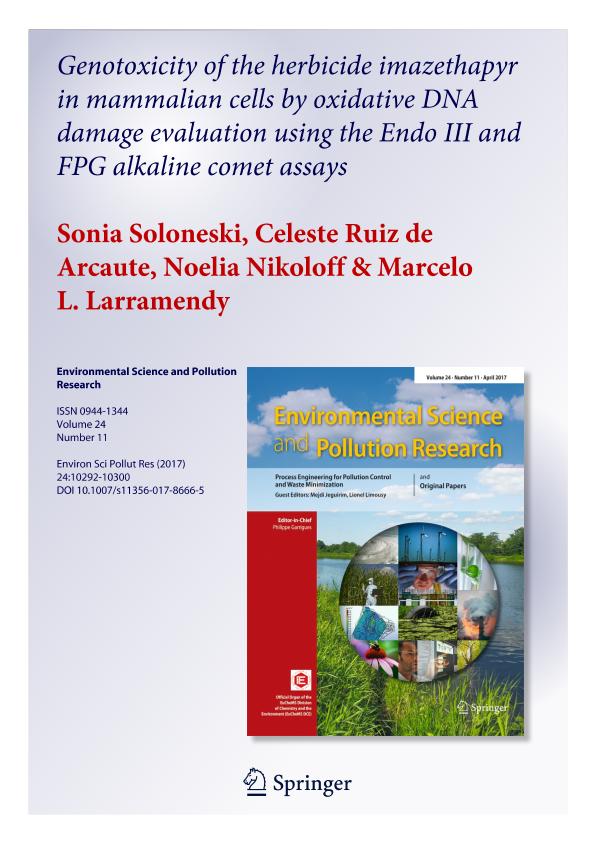Artículo
Genotoxicity of the herbicide imazethapyr in mammalian cells by oxidative DNA damage evaluation using the Endo III and FPG alkaline comet assays
Soloneski, Sonia Maria Elsa ; Ruiz de Arcaute, Celeste
; Ruiz de Arcaute, Celeste ; Nikoloff, Noelia
; Nikoloff, Noelia ; Larramendy, Marcelo Luis
; Larramendy, Marcelo Luis
 ; Ruiz de Arcaute, Celeste
; Ruiz de Arcaute, Celeste ; Nikoloff, Noelia
; Nikoloff, Noelia ; Larramendy, Marcelo Luis
; Larramendy, Marcelo Luis
Fecha de publicación:
04/2017
Editorial:
Springer Heidelberg
Revista:
Environmental Science and Pollution Research
ISSN:
0944-1344
e-ISSN:
1614-7499
Idioma:
Inglés
Tipo de recurso:
Artículo publicado
Clasificación temática:
Resumen
We evaluated the role of oxidative stress in the genotoxic damage induced by imazethapyr (IMZT) and its formulation Pivot® in mammalian CHO-K1 cell line. Using the alkaline comet assay, we observed that a concentration of 0.1 μg/mL of IMZT or Pivot® was able to induce DNA damage by increasing the frequency of damaged nucleoids. To test whether the DNA lesions were caused by oxidative stress, the DNA repair enzymes endonuclease III (Endo III) and formamidopyrimidine-DNA glycosylase (Fpg), which convert base damage to strand breaks, were used. Our results demonstrate that after treatment of CHO-K1 cells with the pure active ingredient as well as the commercial formulation Pivot®, an increase in DNA strand breaks was observed after incubation of both Endo III and Fpg enzymes, indicating that both compounds induce DNA damage involving both pyrimidine and purine-based oxidations, at least in CHO-K1 cells. Our findings confirm the genotoxic potential of IMZT and suggest that this herbicide formulation must be employed with great caution, especially not only for exposed occupational workers but also for other living species.
Archivos asociados
Licencia
Identificadores
Colecciones
Articulos(CCT - LA PLATA)
Articulos de CTRO.CIENTIFICO TECNOL.CONICET - LA PLATA
Articulos de CTRO.CIENTIFICO TECNOL.CONICET - LA PLATA
Citación
Soloneski, Sonia Maria Elsa; Ruiz de Arcaute, Celeste; Nikoloff, Noelia; Larramendy, Marcelo Luis; Genotoxicity of the herbicide imazethapyr in mammalian cells by oxidative DNA damage evaluation using the Endo III and FPG alkaline comet assays; Springer Heidelberg; Environmental Science and Pollution Research; 24; 11; 4-2017; 10292-10300
Compartir
Altmétricas



